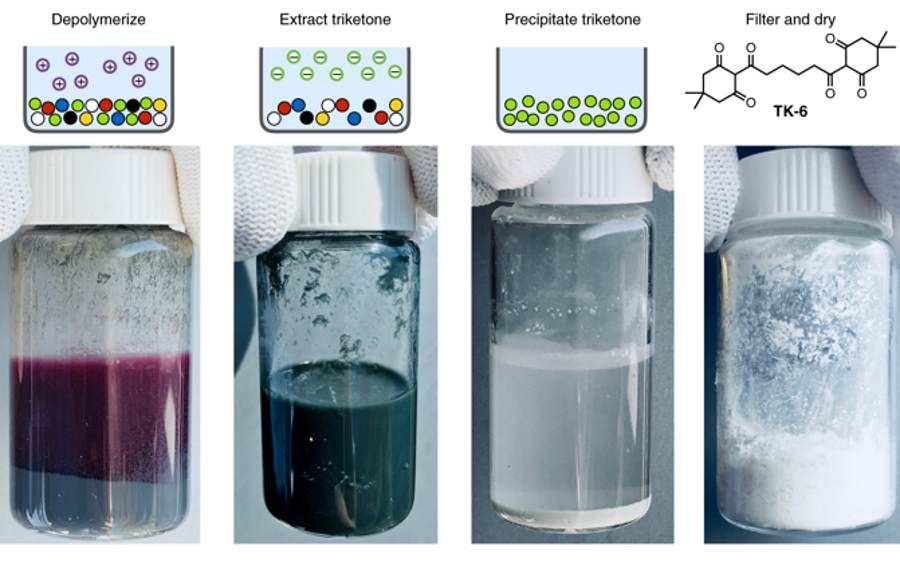The plastic of the future. A material that can be recycled indefinitely
Scientists at Lawrence Berkeley National Laboratory have created a next-generation plastic that can be recycled again and again without loss of quality. The new material, poly(diketoeneamine) or PDK, could be a good alternative to many of the plastics currently used.
Very little of the plastics produced today can be recycled without losing quality. This is due to the roThe various additivesow, such as dyes, fillers or flame retardants. Even the most recyclable plastic – Poly(ethylene terephthalate), in a skrocie PET – is recycled only 20-30 percent, with the rest usually ending up in incinerators or landfillsoin, where it takes centuries to decompose.
To solve the growing plastics crisis, in addition to public awareness work or better waste sortingow, the need to make the recycling process as efficient and simple as possible. A new type of plastic developed at the Berkeley lab seems to have the potential to meet this task.
Teamoł scientistow from Lawrence Berkeley National Laboratory (Berkeley Lab) has designed a recyclable plastic, ktore, much like a set of building blocksoin Lego, can be broken down into their constituent parts at the molecular level and then reassembled into a different shape or texture, without loss of performance or quality. The new material – poly(diketoeneamine) or PDK – was described in the journal „Nature Chemistry”.
– Most plastics have never been recycled. However, we discovered a new wayob assembly of plastics, whichory considers recycling from a molecular perspective,” said the head of theoThe publication’s author Peter Christensen of Berkeley Lab, whoory was part of a multidisciplinary team led by Brett Helms.
All plastics, from water bottles to car parts, are made up of large molecules called polymers. These, in turn, are made up of monomerow, a repeated sequence of smaller compoundsow containing carbon. This network of molecules can be mixed with a wide range of chemicalsow, giving plastics roThe diverse properties thatore allow us to use them for almost anything, from shopping bags to clothing, straws or furniture.
The problem is that this wide range of chemicalow, such as fillers, whichore make plastic harder or plasticizers thatore make plastic flexible – they are tightly bound to monomers and remain in the plastic even after processing at a recycling plant.
During processing, plastics with rotions of different chemical compositions – hard, flexible, transparent and others – are mixed together and ground into pieces of. When a mixture of shredded plastics is melted to produce a new material, it is difficult to predict what properties the new material will inherit from the original plastics, from which it isor which was created.
This legacy has prevented plastic from becoming a material thatory can be recycled over and over again and created from wasteow products of high quality. Thus, advertisingow, instead of being recycled, goes into a furnace to generate heat from it, or into a landfill.
In the case of the new material – PDK – would be possible to reuse the building blocks, from whichorego the product was created. Of course, leaving aside our bad habits, lack of processow and infrastructure and just plain sloppiness, which is the reason we live in an increasingly littered world.
– With PDK, the solid bonds of conventional plastics can be replaced with reversible bonds thatore allow for more efficient processing,” said Helms.
Unlike conventional plastics, monomers from PDKs can be recovered and freed from any complex additivesow simply by immersing the material in a highly acidic solution. The acid helps break the bonds between the monomers and separate them from the additivesoin chemicals, ktore give the plastic its appearance or properties.
Scientists first discovered the exciting property of PDK-based plastics when Christensen experimented with rowith harsh acids, whichore added to glueoin produced from PDK. He noted that the composition of the glue was changing. When considering how theyob glue mohead to be transformed, Christensen analyzed the molecular structure of probki using nuclear magnetic resonance (NMR) spectroscopy. – To our surprise, these were the original monomers,” said Helms.
After testing the rotional preparationsow scientists have shown that the acid not only breaks down PDK polymers into monomers, but also allows the separation of the monomerow since rosorts of additivesow. They went on to demonstrate that recovered PDK monomers can be converted into polymers, and these can form new plastics without inheriting the color or other characteristics of the original material.
Scientists believe their new recyclable plastic could be a good alternative to many of the plastics used today, which theore not recyclable.
– We are at a critical point whereorym we need to think about the infrastructure needed to upgrade recycling facilities for future sorting and processing of wasteow,” said Helms. – If these machines were designed to recycle PDK and related plastics, woThen we could divert plastics from landfills more efficientlyow for processing. This is a good time to start thinking about how to design zarowno materials, as well as recycling facilities, to enable the circulation of plastics, Helms said.
Researchers now plan to develop PDK plastics with a wide range of thermal and mechanical properties for applications as rosion, such as fabrics and 3D printing. In addition, they are trying to expand the composition of PDK by incorporating the materialoin plant origin and other zroThe equivalent sources ofodeł.

